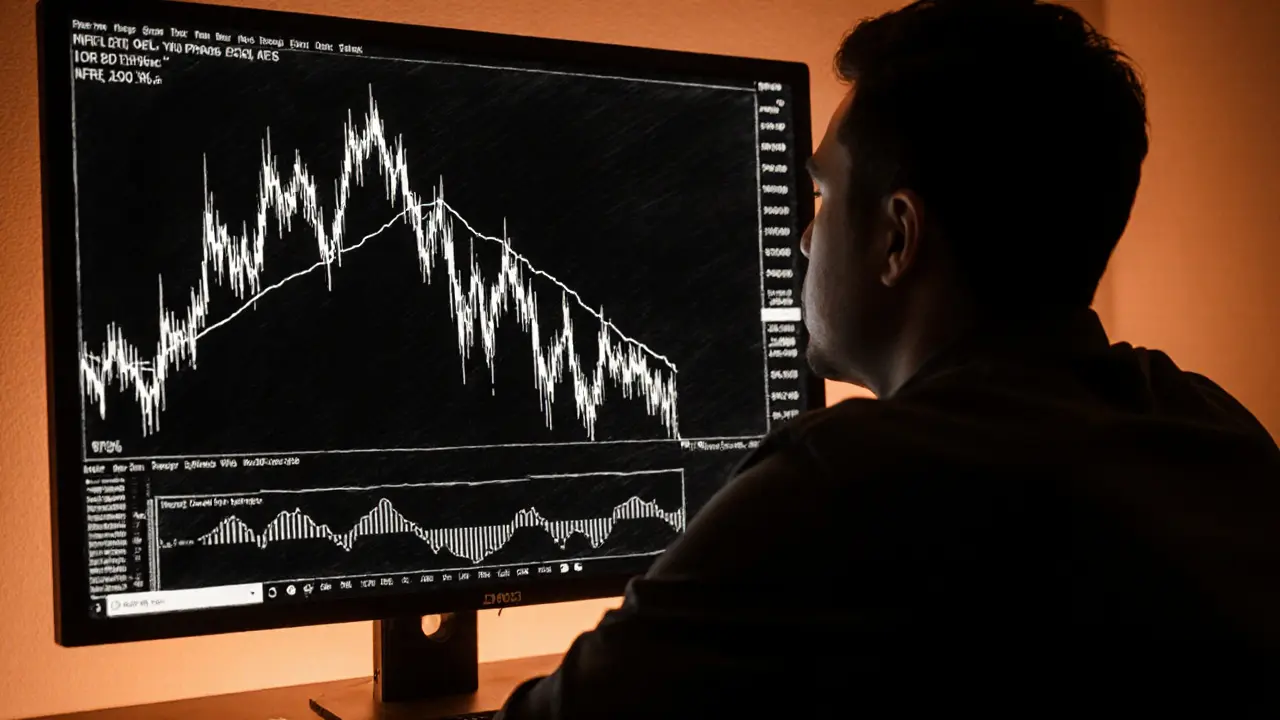Bitcoin Stop-Loss Calculator
Your Stop-Loss Recommendation
When you trade Bitcoin is a decentralized digital currency thatfluctuates 5‑10%daily, protecting your capital becomes a daily habit. One of the most reliable tools is the Bitcoin stop-loss, an automated order that sells your position once the price reaches a level you set. This simple rule lets you walk away from the screen, sleep, or focus on other trades while the market runs 24/7.
Why Use a Stop‑Loss on Bitcoin?
Bitcoin’s price can swing tens of thousands of dollars in a single session. Without a safety net, a sudden drop can wipe out weeks of gains in minutes. A stop‑loss acts like a digital parachute: it kicks in automatically, preventing you from holding a losing position longer than you’re comfortable with.
Professional traders follow a core principle - never risk more than 1‑2% of your total account on any single trade. By aligning a stop‑loss with that rule, you keep losses small enough to stay in the game for the next opportunity.
Types of Bitcoin Stop‑Loss Orders
- Standard Stop‑Loss Order is a simple order that turns into a market order once the trigger price is hit. The execution price is the next available market price, which can be slightly worse during fast moves.
- Stop‑Limit Order converts to a limit order at the trigger price. You set both a stop price and a limit price, giving you price control, but the order may not fill if the market gaps past your limit.
- Trailing Stop‑Loss follows the market upward by a pre‑defined distance (percentage or dollar amount). When the price reverses, the trailing stop locks in the highest price reached, protecting profit.
How to Calculate the Right Stop Level
Two complementary approaches work best: percentage‑based and volatility‑based.
- Percentage Method: Decide the max loss you’re comfortable with - say 5% of the entry price. If you bought Bitcoin at $48,000, a 5% stop lands at $45,600.
- Average True Range (ATR) Method: ATR measures recent volatility. A common rule is to set the stop 1.5‑2×ATR below entry. For a 14‑day ATR of $1,200, a 2×ATR stop would sit $2,400 under the purchase price.
Whichever method you pick, first calculate the dollar amount you’re willing to lose. If your account balance is $20,000 and you cap risk at 2%, the maximum loss is $400. Divide $400 by the price difference between entry and potential stop to determine the appropriate distance.

Setting Up the Order on Popular Exchanges
Most centralized platforms - Binance, Gemini, Bitstamp - expose the same basic controls. Below is a quick walk‑through for Binance, which many traders already use.
- Log in, go to the Trade page and select the BTC/USDT pair.
- Click Stop‑Limit (or Stop‑Loss if the UI separates them).
- Enter your Stop price - the trigger level.
- Enter the Limit price - typically a few dollars below the stop to improve fill odds.
- Specify the quantity of Bitcoin you want to protect.
- Confirm the order. The system now watches the market 24/7.
For a trailing stop on Binance, choose the Trailing Stop tab, set the trailing distance (e.g., 8%), and hit Submit. The stop price will rise automatically as Bitcoin climbs.
Dynamic Adjustments: Trailing and Multi‑Level Stops
Markets rarely move in a straight line. As your trade becomes profitable, you can tighten the stop to lock in gains. A common tactic is the “step‑up” method:
- Enter at $90,000.
- When price hits $95,000, move a standard stop to $92,000 (≈3% below).
- At $100,000, shift the stop to $97,200 using an 8% trailing distance.
This approach lets you stay in the upside while continuously reducing downside exposure.
Advanced traders sometimes stack several stops at different depths - for example, a 3% stop for a small position, a 5% stop for half the position, and an 8% stop for the remainder. If the market drops, the smallest stop exits first, preserving part of the trade while still giving the larger portion a chance to rebound.
Common Pitfalls and How to Avoid Them
Premature triggers. Setting stops right at a psychological round number (e.g., $42,000) can cause early exits because many traders place orders there. Give it a buffer - a few hundred dollars or a percentage below the level.
Too tight a stop. Newbies often use 1‑2% stops, which get knocked out by normal volatility. Aim for 5‑10% on high‑volatility assets unless you have a very small position size.
Ignoring slippage. In a fast‑moving crash, a market stop may execute far below the trigger (e.g., $45,000 trigger fills at $43,050). Mitigate by using stop‑limit orders with a reasonable limit buffer, or by keeping a small portion in a standard stop for rapid exit.
Forgetting to adjust before major events. Treasury announcements, Fed rate decisions, or Bitcoin ETF approvals often cause spikes. Tighten stops a day before if you’re risk‑averse, or widen them if you expect a bullish explosion.
Quick Checklist Before You Trade
- Determine max risk per trade (1‑2% of account).
- Choose stop method - percentage or ATR‑based.
- Identify nearest support level and add a buffer.
- Set order type: standard stop, stop‑limit, or trailing.
- Double‑check quantity matches your risk calculation.
- Review upcoming news events and adjust if needed.
- Monitor after execution - tighten or widen as price moves.
| Order Type | How It Triggers | Pros | Cons |
|---|---|---|---|
| Standard Stop‑Loss | Turn into market order at stop price | Simple, guaranteed execution | Possible slippage during fast moves |
| Stop‑Limit | Convert to limit order at stop price | Control over execution price | May not fill if market gaps |
| Trailing Stop | Stop price moves upward with market | Locks in profit while staying in trade | Complex to set; can be wide during high volatility |

Frequently Asked Questions
What’s the difference between a stop‑loss and a stop‑limit?
A stop‑loss becomes a market order as soon as the trigger price is hit, ensuring the order fills but possibly at a worse price. A stop‑limit turns into a limit order, so you set the worst acceptable price, but the trade might not execute if the market moves past that limit.
How far from the entry price should I place my first stop?
Most traders start with a 5‑10% distance or 1.5‑2× the 14‑day ATR. Adjust the exact figure based on your risk tolerance and the current volatility environment.
Can I use stop‑loss orders on decentralized exchanges?
DeFi platforms are catching up, but most still lack native stop‑loss features. Traders often rely on third‑party bots or wrapper contracts that monitor the price and submit market orders when conditions are met.
What should I do if my stop‑loss gets slippage during a crash?
Accept that slippage is part of trading volatile assets. To reduce its impact, keep a small portion of the position in a standard market stop for rapid exit, while the rest uses a stop‑limit with a wider limit buffer.
Do I need to reset my stop‑loss after every price spike?
If the market continues a clear trend, move the stop upward (or tighten a trailing stop). If the price is whipsawing, consider widening the stop to avoid being knocked out by normal noise.


Wow, an interactive stop‑loss calculator-because reading a spreadsheet was just too much work.
It's an absolute tragedy that people keep throwing money at Bitcoin without even a basic risk plan. The whole market is a circus, and this guide pretends to be the ringmaster. If only everyone cared about discipline, the chaos would end. But no, we love the hype.
Anyone still relying on a glorified spreadsheet for stop‑losses is living in the dark ages of trading. The guide glosses over slippage, liquidity cliffs, and the brutal reality of exchange outages. It assumes perfect execution, which is a fantasy as dangerous as moon‑bathing without sunscreen. If you think you can outsmart the market with a simple calculator, you’re setting yourself up for a spectacular loss. Wake up and read real research.
Hey folks, great that you’re looking into risk management! A solid stop‑loss is the backbone of any successful strategy. Start small, test the tool and adapt it to your own risk tolerance. You’ll find that consistency beats wild speculation every time. Keep it up and stay disciplined!
Absolutely! 🌍 It’s fascinating how different regions view crypto risk – some treat it like a volatile commodity, others as a sovereign asset. This calculator could bridge those perspectives if we tweak the parameters for local market depth. Let’s keep sharing insights across borders! 😊
Nice tool, seems user‑friendly enough for a quick glance.
Honestly, anyone still using this half‑baked calculator is just feeding the market’s hype machine. You need real data, not this DIY gimmick.
While the interface appears streamlined; the underlying assumptions-such as constant volatility and immediate order execution-are, frankly, overly idealistic; this undermines practical applicability!!!
The guide does a decent job breaking down the math, but remember that stop‑losses are only as good as the market conditions at execution. It’s wise to combine this tool with real‑time monitoring.
In contrast to the prevailing optimism surrounding such calculators, one might contend that reliance upon them engenders a false sense of security; prudent traders should instead cultivate a nuanced understanding of order book dynamics and avoid over‑dependence on any singular metric.
When we think about risk, we’re really contemplating the unknown that lies between certainty and chaos. A stop‑loss is a promise we make to ourselves, a boundary drawn in the sand of a market that has no real shore. If we respect that line, perhaps we honor the very nature of uncertainty itself.
Great job! Keep refining your strategy. 👍
Our market deserves tools built at home, not these foreign gimmicks. Use something made by local experts.
The presented Bitcoin stop‑loss calculator purports to democratize risk management by abstracting complex quantitative methodologies into a user‑friendly interface.
While the abstraction ostensibly lowers the barrier to entry, it concurrently obfuscates the underlying stochastic processes that govern price dynamics.
Specifically, the model assumes a stationary distribution of returns, which is empirically contradicted by the leptokurtic nature of cryptocurrency price series.
Moreover, the reliance on a singular volatility estimator-namely the Average True Range-fails to capture the multifractal scaling behavior observed in high‑frequency data.
Practitioners must therefore calibrate the ATR period with caution, recognizing that a shorter window may exacerbate noise, whereas an overly extended window may smooth out pertinent regime shifts.
Additionally, the calculator does not account for market microstructure effects such as order‑book depth, slippage, and execution latency, all of which can materially alter the realized stop‑loss price.
In the context of a fragmented liquidity landscape, the assumption of perfect fill at the computed stop level is a theoretical ideal rather than a practical certainty.
Furthermore, the absence of a dynamic position sizing algorithm-one that integrates conditional value at risk (CVaR) and tail risk metrics-limits the tool's applicability for sophisticated portfolio allocation.
Risk‑adjusted return considerations, such as the Sharpe ratio or Sortino ratio, are conspicuously omitted, thereby reducing the holistic assessment of trade viability.
It is also prudent to underscore that the deterministic nature of the percentage‑based method neglects the conditional heteroskedasticity inherent in GARCH‑type models.
Consequently, traders who uncritically adopt the recommended stop‑loss levels may inadvertently expose themselves to tail events that exceed the stipulated risk tolerance.
A recommended best practice is to complement the calculator's output with scenario analysis, Monte Carlo simulations, or stress testing against historical drawdown periods.
Integrating such quantitative robustness checks can mitigate model risk and enhance the resilience of the trading strategy.
In summary, while the calculator serves as an introductory pedagogical aid, its deployment in live trading environments should be contingent upon supplemental methodological rigor.
Failure to augment the tool with comprehensive risk analytics may result in suboptimal capital preservation outcomes.